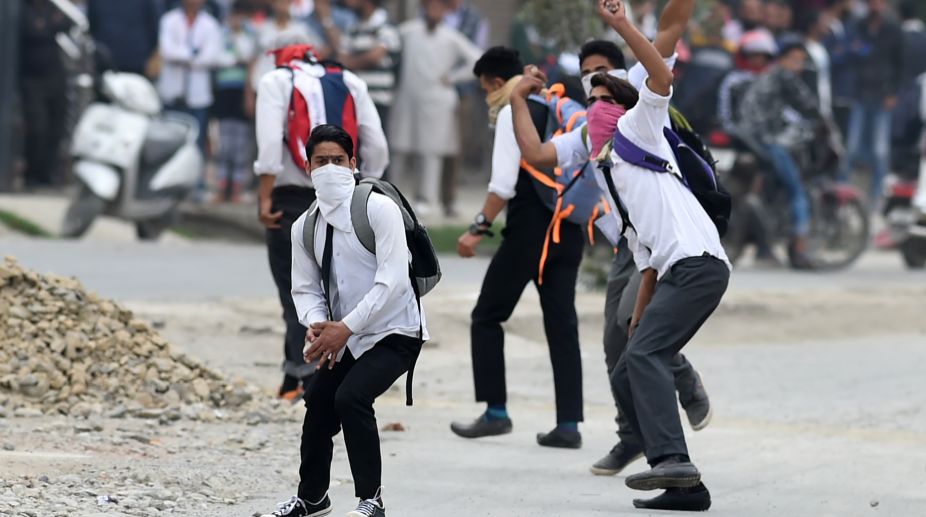Sana Mir and Usain Bolt named ambassadors of ICC T20 WC Qualifier 2024
Former Pakistan skipper Sana Mir and eight-time Olympic gold medallist Usain Bolt have been named as the ambassadors of women’s and men’s ICC T20 World Cup Qualifier 2024.

(Photo: AFP)
Extremism and violence are latent qualities in every individual which remain subdued unless ignited by an external force.
This force may be an extreme belief in religion or an orator with the ability to mould his audience by the power of his speech or a violent incident which impacts the individual. The most dangerous orator is one who invokes religion for indulging or supporting violence. In addition, if society lacks means of channelising latent energy of youth into productive ventures, then it compels them to expend it in negative actions.
The valley is an example of how local youth have been manipulated into turning anti-state and compelled to resort to violence for the flimsiest of reasons. Over decades, Kashmiri youth have been bombarded with the thought that the valley should not be a part of India but an independent nation, solely because of its demography. Rumours engulf the region at frequent intervals sometimes to say that a Hindu India seeks to alter their religious majority status.
Advertisement
Thus, violence broke out over allocation of land to the Amarnath Yatra shrine board, while the state blocked release of land for ex-servicemen colonies and resettlement of Kashmiri Pundits. The anger against possible removal of Article 35 A is a result of this syndrome. There is an element within the state seeking merger with Pakistan, solely on grounds of religious ethnicity.
This element includes militants inducted from Pakistan, pro-Pak Hurriyat and their supporters. The masses are befooled by statements that the will of the people will decide the future of the state once it breaks free of Indian shackles. Thus the population had begun believing that their demand for azaadi could only be met by violence as a means of freedom struggle and Pakistan would support their choice.
This thought has been enunciated from mosques, social media emanating from Pakistan and the Hurriyat. Pakistan has always stated that it seeks merger of Kashmir and has never once mentioned supporting an independent nation.
A statement by the POK Prime Minister, post the ouster of Nawaz Sharif, that he has doubts about remaining with Pakistan, created a controversy.
Pakistan presupposes that if given an option the valley will merge with it. Hence the idea being injected into the minds of the youth cannot be further from the truth. Regular indoctrination of this belief in every forum over decades has poisoned minds; changing these would require a long-term plan, rather than hard overnight action, as being considered at present.
There is no political party, forum, organisation or even an NGO, which can initiate debates at various levels in the valley, enabling truth to flow. Complete breakdown of communication between those governing and the governed has adversely impacted the valley.
The valley was unique in many ways. There were roads with bus services to each village, every individual owned property and poverty was negligible. Financially, there was a sense of security. However, since militancy commenced, many aspects have changed.
Most of the youth at the forefront of the agitation have hardly set foot outside the region, lack knowledge of developments in the rest of the country, availability of opportunities and hence possess a narrow mindset. Schools have been burnt, compelling youth to study in madrassas which restrict free thought, while driving in a Wahhabist mentality.
Religious restrictions and threats for not adhering to customs by terror groups over the years have made the valley more religious than ever before. Since the ethnic cleansing of Kashmiri Pundits (the present generation has been born after it), the valley has only witnessed calls for prayer for one religion, hence the youth seek to ensure it remains the same.
In such a closed environment, rumours spread fast and wild, These are specially designed to incite and anger youth to resort to violence at any given opportunity. There are very limited avenues for Kashmiri youth to release pent-up energy. Entertainment in the valley is missing, cinema houses are shut, playgrounds are few and programmes on television are mostly based on religion, being broadcast from Pakistan or Saudi Arabia.
The influence of religion, pushed by hardliners, has further restricted television entertainment for the masses. Hence for youth, there is no means of releasing pressure or surplus energy. Due to lack of employment opportunities frustration has built, resulting in quicker acceptance of rumours. Being paid for stone throwing also benefits.
Videos of school or college students dancing to tunes of azadi, prior to resorting to stone throwing, indicates that most consider it as a means of entertainment rather than anger against the state. Stone throwing therefore is an outlet for release of internal pressures and not solely anger against the state. Sporting events, mainly organized by the army, on the limited fields available, are actively subscribed to.
Participation is immense and so is the enthusiasm. Events including inter-village cricket tournaments, women’s football matches and youth festivals have seen large attendance. No event has been marred by stone pelting, Pakistan flags being waved or by cries of azadi. Football and cricket are two games drawing mass participation. There have been calls from moderates for conducting district level cricket and football tournaments to change youth mindsets, which the state has ignored.
Active participation in the limited sporting ventures on offer suggests that youth are crying out to be engaged, seeking opportunities for releasing pent up feelings and pressures. If such action is adopted and the state supports it, stone throwing may become a rarity.
There must be a coordinated effort to change the environment, introduce mass activities which involve youth participation, while ensuring functioning of schools, if we wish to witness a change in attitudes.
(The writer is a retired Major-General of the Indian Army)
Advertisement